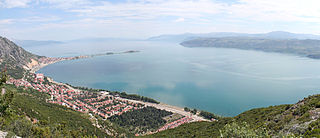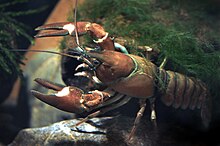
Mälaren, historically referred to as Lake Malar in English, is the third-largest freshwater lake in Sweden. Its area is 1,140 km2 and its greatest depth is 64 m. Mälaren spans 120 kilometers from east to west. The lake drains, from south-west to north-east, into the Baltic Sea through its natural outlets Norrström and Söderström and through the artificial Södertälje Canal and Hammarbyleden waterway. The easternmost bay of Mälaren, in central Stockholm, is called Riddarfjärden. The lake is located in Svealand and bounded by the provinces of Uppland, Södermanland and Västmanland. The two largest islands in Mälaren are Selaön (91 km2) and Svartsjölandet (79 km2). Mälaren is low-lying and mostly relatively shallow.

Crayfish are freshwater crustaceans belonging to the infraorder Astacidea, which also contains lobsters. Taxonomically, they are members of the superfamilies Astacoidea and Parastacoidea. They breathe through feather-like gills. Some species are found in brooks and streams, where fresh water is running, while others thrive in swamps, ditches, and paddy fields. Most crayfish cannot tolerate polluted water, although some species, such as Procambarus clarkii, are hardier. Crayfish feed on animals and plants, either living or decomposing, and detritus.

Astacus is a genus of crayfish found in Europe, comprising three extant (living) species and three extinct fossil species.
Crayfish plague is a water mold that infects crayfish, most notably the European Astacus which dies within a few weeks of being infected. When experimentally tested, species from Australia, New Guinea and Japan were also found to be susceptible to the infection.

Cambaroides japonicus, also known as Japanese crayfish, is a species of crayfish endemic to Japan.

Astacus astacus, the European crayfish, noble crayfish, or broad-fingered crayfish, is the most common species of crayfish in Europe, and a traditional food source. Like other true crayfish, A. astacus is restricted to fresh water, living only in unpolluted streams, rivers, and lakes. It is found from France throughout Central Europe, to the Balkan Peninsula, and north as far as Scandinavia and Finland, and Eastern Europe. Males may grow up to 16 cm long, and females up to 12 cm.

Pacifastacus is a genus of crayfish native to western North America, containing six species, two of which are extinct:

Eğirdir is a lake in the Lakes Region of Turkey. The town of Eğirdir lies near its southern end, 107 kilometers north of Antalya. With an area of 482 square kilometres (186 sq mi) it is the fourth largest lake in Turkey, and the second largest freshwater lake.

Astacidae is a family of freshwater crayfish native to Europe, western Asia and western North America. The family is made up of four extant (living) genera: The genera Astacus, Pontastacus, and Austropotamobius are all found throughout Europe and parts of western Asia, while Pacifastacus is native to western United States and British Columbia, but has also been introduced elsewhere.

Pacifastacus fortis is an endangered crayfish species endemic to Shasta County, California, where it is found only in isolated spots on the Pit River and Fall River Mills. The exact subpopulations for the Shasta crayfish were discovered in 2004 through a genetic study that determined three different genetic clusters: Crystal Lake, the Big Lake group, and Thousand Springs.

Procambarus clarkii, known variously as the red swamp crayfish, Louisiana crawfish or mudbug, is a species of cambarid crayfish native to freshwater bodies of northern Mexico, and southern and southeastern United States, but also introduced elsewhere, where it is often an invasive pest.

Austropotamobius pallipes is an endangered European freshwater crayfish, and the only crayfish native to the British Isles. Its common names include white-clawed crayfish and Atlantic stream crayfish.

Pacifastacus nigrescens, the sooty crayfish, is an extinct species of crayfish in the family Astacidae. It was originally described in 1857 by William Stimpson from the area around San Francisco, where it was once common in the creeks surrounding San Francisco Bay. The signal crayfish, Pacifastacus leniusculus was introduced to California, probably in the 19th century, and since then, no sightings of P. nigrescens have been made; it is now believed to be extinct. Intensive searches of its former habitat have found that every site where it once occurred is now occupied by either the signal crayfish or Procambarus clarkii.

Faxonius limosus, synonym Orconectes limosus, is a species of crayfish in the family Cambaridae. It is native to the east coast of North America, from Quebec to the lower James River, Virginia, but has also been introduced to Europe. It is known commonly as the spinycheek crayfish or Kamberkrebs in German.

Islands, such as the British Isles, can be adversely affected by the introduction of non-native species. Often an island will have several distinct species not present on the nearest mainland, and vice versa. The native flora and fauna of islands which have been isolated for a longer period of time such as New Zealand or Hawaii are more vulnerable than islands such as Great Britain and Ireland, which became isolated more recently.

Faxonius virilis is a species of crayfish known as the virile crayfish, northern crayfish,eastern crayfish, and lesser known as the lake crayfish or common crawfish. Faxonius virilis was reclassified in August 2017, and the genus was changed from Orconectes to Faxonius. It is native to the central United States, east to tributaries of Lake Erie, Lake Ontario, Lake Champlain and the St. Lawrence River in New York and to much of Canada.

Stephanie Peay is a British ecologist and crayfish researcher.

Invasive species are a significant threat to many native habitats and species of the United States and a significant cost to agriculture, forestry, and recreation. The term "invasive species" can refer to introduced/naturalized species, feral species, or introduced diseases. Some introduced species, such as the dandelion, do not cause significant economic or ecologic damage and are not widely considered as invasive. Economic damages associated with invasive species' effects and control costs are estimated at $120 billion per year.

Crayfish are eaten all over the world. Like other edible crustaceans, only a small portion of the body of a crayfish is edible. In most prepared dishes, such as soups, bisques and étouffées, only the tail portion is served. At crawfish boils or other meals where the entire body of the crayfish is presented, other portions, such as the claw meat, may be eaten.




















